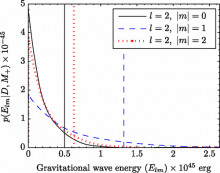
Abstract
The physical mechanisms responsible for pulsar timing glitches are thought to excite quasinormal mode oscillations in their parent neutron star that couple to gravitational-wave emission. In August 2006, a timing glitch was observed in the radio emission of PSR B0833-45, the Vela pulsar. At the time of the glitch, the two colocated Hanford gravitational-wave detectors of the Laser Interferometer Gravitational-wave observatory (LIGO) were operational and taking data as part of the fifth LIGO science run (S5). We present the first direct search for the gravitational-wave emission associated with oscillations of the fundamental quadrupole mode excited by a pulsar timing glitch. No gravitational-wave detection candidate was found. We place Bayesian 90% confidence upper limits of 6.3×10-21 to 1.4×10-20 on the peak intrinsic strain amplitude of gravitational-wave ring-down signals, depending on which spherical harmonic mode is excited. The corresponding range of energy upper limits is 5.0×1044 to 1.3×1045 erg.